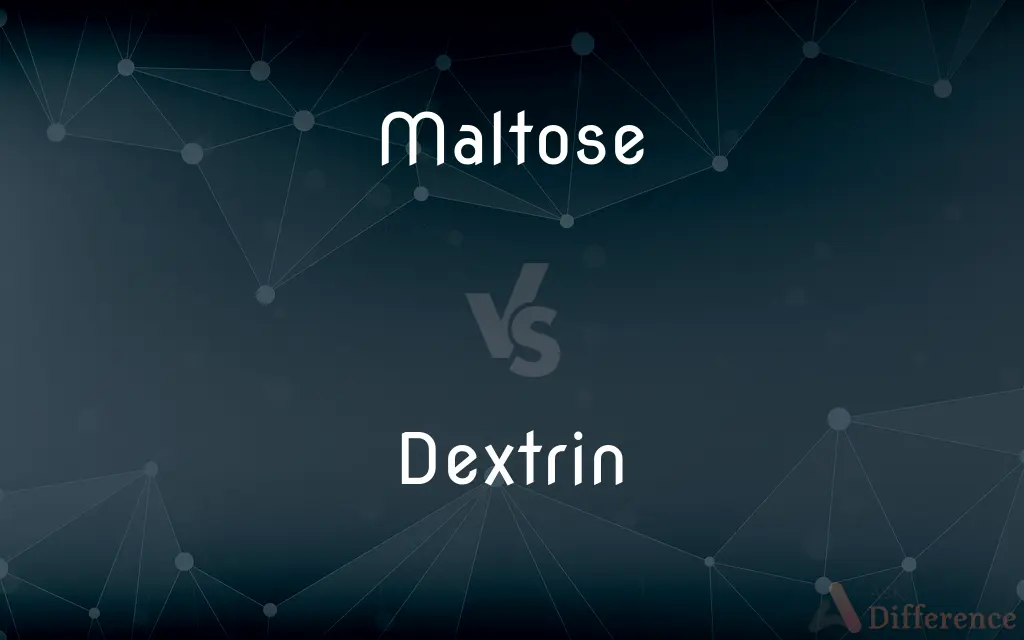Maltose vs. Dextrin — What's the Difference?
Edited by Tayyaba Rehman — By Urooj Arif — Updated on March 12, 2024
Maltose, a disaccharide formed from two glucose units, is known for its role in brewing and digestion, whereas dextrin, a polysaccharide, is used for its thickening and binding properties.

Difference Between Maltose and Dextrin
Table of Contents
ADVERTISEMENT
Key Differences
Maltose and dextrin are carbohydrates that play significant roles in food science and various industries, yet they differ fundamentally in structure and function. Maltose is a disaccharide, consisting of two glucose molecules linked together, primarily found in germinating grains and produced during the digestion of starch. It is known for its sweetness and its role in fermentation processes, such as in brewing beer. Dextrin, on the other hand, is a polysaccharide formed by the partial hydrolysis of starch. It comprises a complex chain of glucose units and is less sweet than maltose. Dextrin is widely used as a thickening agent, filler, or glue in food products and other industrial applications.
In terms of digestion and nutritional value, maltose is broken down by the enzyme maltase into two glucose molecules, which are then used by the body for energy. This makes maltose a quick source of energy, albeit contributing to sugar levels. Dextrin, with its more complex structure, is digested more slowly and can have varying impacts on sugar, depending on its composition and molecular weight. It is often used in dietary products as a fiber supplement or to manage glycemic response.
The production processes for maltose and dextrin also differ. Maltose is produced naturally in the malting process of grains and through enzymatic action in the human digestive system. Commercially, it can be produced by breaking down starch with enzymes or acids. Dextrin is produced by heating starch in the presence of acid or enzymes, a process known as dextrinization, which breaks the starch down into shorter glucose chains.
Regarding their applications, maltose is primarily used in the food and beverage industry, particularly in brewing and as a sweetener in various products. Its role in fermentation is crucial for the production of alcohol and the flavor development in bread. Dextrin finds broader applications, not only as a food additive for texture and moisture retention but also in non-food industries, such as in adhesives, textiles, and pharmaceuticals, due to its binding properties and solubility.
While both maltose and dextrin are derived from starch and consist of glucose units, their differences in molecular structure lead to distinct functional properties, digestive behaviors, and applications in various industries.
ADVERTISEMENT
Comparison Chart
Composition
Disaccharide (two glucose units)
Polysaccharide (complex chain of glucose units)
Sweetness
Sweet
Less sweet than maltose
Digestion
Quickly digested into glucose
Slower digestion, varies by type
Main Uses
Brewing, sweetener in foods
Thickening agent, filler, glue in foods and industrial products
Production
Malting process, enzymatic breakdown of starch
Partial hydrolysis of starch through heating with acid or enzymes
Compare with Definitions
Maltose
Maltose is a disaccharide made of two glucose molecules.
Maltose is crucial in the brewing process for beer.
Dextrin
Dextrin is a polysaccharide derived from starch.
Dextrin is used to improve the mouthfeel of processed foods.
Maltose
Maltose is used as a natural sweetener.
Maltose syrup is added to candies for sweetness.
Dextrin
Used in both food and non-food applications.
Dextrin-based adhesives are found in envelopes and labels.
Maltose
Found in germinating grains.
Maltose levels increase in barley during malting.
Dextrin
Can serve as a dietary fiber.
Dextrin supplements are used to promote digestive health.
Maltose
It is produced during the digestion of starch.
Enzymes in saliva convert starch into maltose during chewing.
Dextrin
It acts as a thickening agent.
Dextrin thickens sauces without altering flavor.
Maltose
Known for its role in fermentation.
Maltose fermentation by yeast produces alcohol.
Dextrin
Produced by heating starch.
The production of dextrin involves dextrinization at high temperatures.
Maltose
Maltose ( or ), also known as maltobiose or malt sugar, is a disaccharide formed from two units of glucose joined with an α(1→4) bond. In the isomer isomaltose, the two glucose molecules are joined with an α(1→6) bond.
Dextrin
Dextrins are a group of low-molecular-weight carbohydrates produced by the hydrolysis of starch or glycogen. Dextrins are mixtures of polymers of D-glucose units linked by α-(1→4) or α-(1→6) glycosidic bonds.
Maltose
A sugar produced by the breakdown of starch, e.g. by enzymes found in malt and saliva. It is a disaccharide consisting of two linked glucose units.
Dextrin
A soluble gummy substance obtained by hydrolysis of starch, used as a thickening agent and in adhesives and dietary supplements.
Maltose
A white disaccharide, C12H22O11, formed during the digestion of starch. Also called malt sugar.
Dextrin
Any of various soluble polysaccharides obtained from starch by the application of heat or acids and used mainly as adhesives and thickening agents.
Maltose
(carbohydrate) A disaccharide, C12H22O11 formed from the digestion of starch by amylase; is converted to glucose by maltase; it is an isomer of trehalose
Dextrin
(carbohydrate) Any of a range of oligomers of glucose, intermediate in complexity between maltose and starch, produced by the enzymatic hydrolysis of starch; used commercially as adhesives.
Maltose
A crystalline disaccharide (C12H22O11) formed from starch by the action of diastase of malt, and the amylolytic ferment of saliva and pancreatic juice; called also maltobiose and malt sugar. Chemically it is 4-O-
Dextrin
A translucent, gummy, amorphous substance, nearly tasteless and odorless, used as a substitute for gum, for sizing, etc., and obtained from starch by the action of heat, acids, or diastase. It is of somewhat variable composition, containing several carbohydrates which change easily to their respective varieties of sugar. It is so named from its rotating the plane of polarization to the right; - called also British gum, Alsace gum, gommelin, leiocome, etc. See Achroödextrin, and Erythrodextrin.
Maltose
A white crystalline sugar formed during the digestion of starches
Common Curiosities
What is the main difference between maltose and dextrin?
The main difference lies in their molecular structure; maltose is a disaccharide with two glucose units, whereas dextrin is a polysaccharide with a complex chain of glucose units.
Do maltose and dextrin have the same impact on sugar level?
No, maltose is quickly digested into glucose, potentially raising sugar levels, while dextrin’s impact varies by type and is generally digested more slowly.
Can both maltose and dextrin be used in foods?
Yes, both are used in food production, with maltose serving as a sweetener and fermentation ingredient, and dextrin used as a thickening agent, filler, or fiber supplement.
How are maltose and dextrin produced?
Maltose is produced naturally in germinating grains and by enzymatic breakdown of starch. Dextrin is produced through the partial hydrolysis of starch by heating it with acid or enzymes.
Can dextrin be used as a sweetener like maltose?
Dextrin is less sweet than maltose and is typically not used as a sweetener; its primary roles are as a thickener, filler, or dietary fiber in foods.
Are maltose and dextrin interchangeable?
No, they serve different purposes due to their structural differences and are chosen for specific roles in food processing and other applications.
What are some common products that contain maltose?
Common products include beer, malted milk, cereals, and some sweets where maltose is used for its sweetening and fermentative properties.
Why is dextrin added to non-food products?
Dextrin is added to non-food products like adhesives and textiles for its binding properties, solubility, and as a thickening agent, leveraging its versatile functional qualities.
Is maltose or dextrin better for health?
It depends on the context; maltose can provide quick energy but affect blood sugar levels, while dextrin can offer dietary fiber benefits, but their health impacts vary based on individual dietary needs and conditions.
How does the role of maltose in brewing differ from dextrin’s use in food?
Maltose is fermented by yeast to produce alcohol in brewing, while dextrin is used to modify texture, act as a filler, or enhance mouthfeel in food products without fermentation.
Share Your Discovery

Previous Comparison
Rig vs. Truck
Next Comparison
Frequency vs. HertzAuthor Spotlight
Written by
Urooj ArifUrooj is a skilled content writer at Ask Difference, known for her exceptional ability to simplify complex topics into engaging and informative content. With a passion for research and a flair for clear, concise writing, she consistently delivers articles that resonate with our diverse audience.
Edited by
Tayyaba RehmanTayyaba Rehman is a distinguished writer, currently serving as a primary contributor to askdifference.com. As a researcher in semantics and etymology, Tayyaba's passion for the complexity of languages and their distinctions has found a perfect home on the platform. Tayyaba delves into the intricacies of language, distinguishing between commonly confused words and phrases, thereby providing clarity for readers worldwide.














































